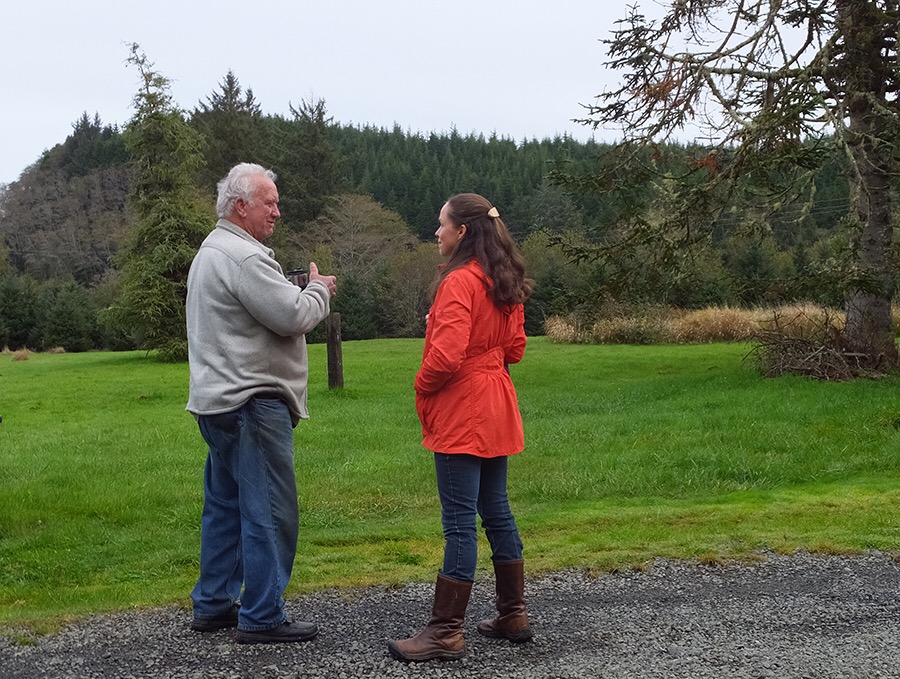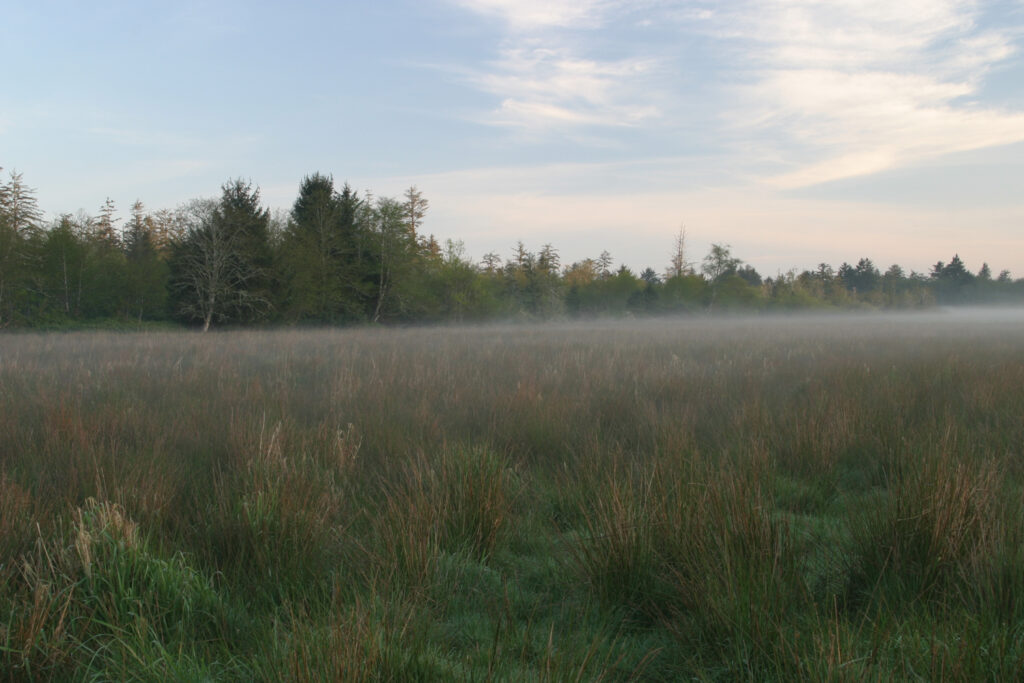Twenty years ago, a small nonprofit organization—just on the cusp of young adulthood—had a vision for 364 acres of land in the Necanicum Watershed, at the base of Tillamook Head.
They imagined it as a place that could bring together conservation and community in a meaningful way. However, deciding to pursue acquisition of what would become the Circle Creek Habitat Reserve wasn’t necessarily straightforward.

While the land included frontage along Circle Creek and the Necanicum River, as well as intact spruce- and cedar-swamp wetlands, it also was being used as farmland at the time. Additionally, North Coast Land Conservancy had never implemented a fundraising campaign; the batch of smaller properties conserved up to that point all were donated. Staff capacity was slight, with an enormous reliance on volunteerism.
But with founding Executive Director Neal Maine at the helm, NCLC stepped forward and made a plan for what would be a landmark acquisition that ushered in a new phase of life for the organization.
“Circle Creek is the icon of where we learned to do it right,” Neal says. “And it was a whole new world.”
Current Executive Director Katie Voelke, who was one of only three staff members at the time, agrees. “Taking on this responsibility felt like taking on the responsibility of ensuring the organization kept its pledge of forever,” she says. “It launched all of what has come after that.”
The ‘Heart and Soul’ of NCLC
NCLC learned more about fundraising and development to raise $1.2 million for the reserve, along with maturing in the areas of strategic planning, governance-capacity building, staffing, doing due diligence—all the things that are now inherently part of NCLC. The project highlighted how nature-based land-trust protection is “sort of an art form and a business,” Neal says, adding, “You need inspiration from the beauty of the landscape, but you’re dealing with real cash—a million-plus dollars. You’ve got to have your act together.”
Additionally, there was a strong community connection to Circle Creek. Many people were familiar with the property for a variety of reasons, whether they grew up with the Rippet family, or worked for the owner, Russ Earl, on his farm.
By rallying the community around the project, it helped solidify the trajectory NCLC already was on, one that was markedly different within the environmental movement, where conservation groups were perceptively pitted against developers, loggers, or even communities at large. NCLC strove for a cooperative and collaborative, rather than combative, approach to conservation that recognized and celebrated how projects could be mutually beneficial.
Circle Creek is the icon of where we learned to do it right. And it was a whole new world.
Neal Maine, founding Executive Director of NCLC
“That new vision was the heart and soul of the land trust coming to life,” Neal says.
The Circle Creek project provided an opportunity for a wide range of people to get involved. For instance, Neal remembers a group of cheerleaders from the local high school hosting a couple of weekend carwashes to help fundraise for the acquisition. Even though it was a small portion of the amount needed, it demonstrated how many people were galvanized to pitch in at various levels.
“This is community; this is the way it is,” Neal remembers thinking. “That became almost the methodology for the land trust. You’ve got to work with the landowner. You’ve got to have a broad base of people who have the potential to understand what you’re trying to do.”
And that’s what people understood about Circle Creek: The land could better serve the community by being conserved.
Developing a Home at Circle Creek
At the time of acquisition, Circle Creek had spent decades as converted land, used for agriculture and grazing. Portions of it were mowed for pasture. It had three big buildings established.
As Neal says, “It had a lot of baggage. You had to have maybe been around the block a couple times to see the real potential.”
That potential included valuable ecological characteristics such as a portion of forestland; a major confluence zone in the Necanicum Watershed; priority habitat for local flora and fauna; and the presence of a floodplain.

The intact and high-functioning spruce- and cedar-swamp wetlands were also a main focal point, Katie recalls. That habitat type used to be quite prevalent but now is very rare, with only 3 percent of lower watershed forests and wetlands remaining.
“You can tell it’s an old forest, dripping with moss and lichen, massive branches and tree trunks,” she says. “Those are the reasons why a conservation group would be interested in it.”
Over the next 20 years, those key components were preserved while thoughtful planning and restoration began to positively affect those the portions of the reserve carrying the “baggage,” so to speak.
A year after the acquisition, NCLC turned the two-story house at Circle Creek into an office, providing the organization with a home base.
“That was a key part of giving us some identity about who we were and where we were,” Neal says.
NCLC used the barns to store maintenance equipment and supplies for stewardship projects, and to host gatherings, events, and activities through the year. Additionally, invasive-plant management and restoration projects began to take place.
“We were able to cultivate our volunteer community, because we had this home and this place where the story just told itself. They could come out here and know what it was about,” Katie says. “All of those things make Circle Creek an important anchor.”

A New Beginning at Circle Creek
The year 2012 brought heartache for NCLC—as well as an opportunity for reflection. The office at Circle Creek was destroyed in an arson fire.
“It was a really hard year for NCLC after that,” Katie says. “But at the same time, there was so much support and desire to help us through that. All kinds of community members, particularly in Seaside, were offering any number of things, from a spare computer monitor to a place to set up shop. It was just inspiring, knowing people wanted us to make it through.”
Katie herself journeyed through a juxtaposition of emotions, from feeling “it’s all lost” to realizing “it’s all okay,” as she focused on what exactly it is. What the heart of the organization is.
The building, the records, the equipment, “that’s not what it is,” she says. “The results of our work was all still here. Our people were still here. The conserved land was still here.”
And those things have continued to persevere and grow and strengthen since the fire. The work has continued. The mission has thrived.
We were able to cultivate our volunteer community, because we had this home and this place where the story just told itself. They could come out here and know what it was about. All of those things make Circle Creek an important anchor.
Katie Voelke, NCLC Executive Director
In 2013, NCLC and its partners completed a landmark floodplain restoration project at Circle Creek, allowing the land to naturally flood during high-water events and mitigating flooding of the adjacent U.S. Highway 101. The project involved removing a levy from the Necanicum River, in effect letting nature’s floodplain gather the floodwaters and reducing water accumulation on the highway by approximately 12 inches. It was a natural solution to help the wetland at Circle Creek revert back into the sort of sponge it’s designed to be.
A couple of years later, NCLC acquired the Boneyard Ridge Habitat Reserve that connects to Circle Creek and expands up Tillamook Head, reinforcing habitat connectivity within the area.
“It just continued to show us the real potential of this being a pretty major anchor for conservation in the watershed—the heart of the system—and a place where we could really welcome community,” Katie says.
Now, she walks out on the property and sees a plethora of trees planted as part of restoration 20 years ago. Those trees have transformed into an impressive forest.
“That happened already,” Katie says. “And there is still all of time to come for those trees, and that forest, and this floodplain. In that way, this place is such an experiential example of the power of taking care of the environment. You can really make a difference, you can affect it, you can see it, and that change happens in your lifetime.”
Comments